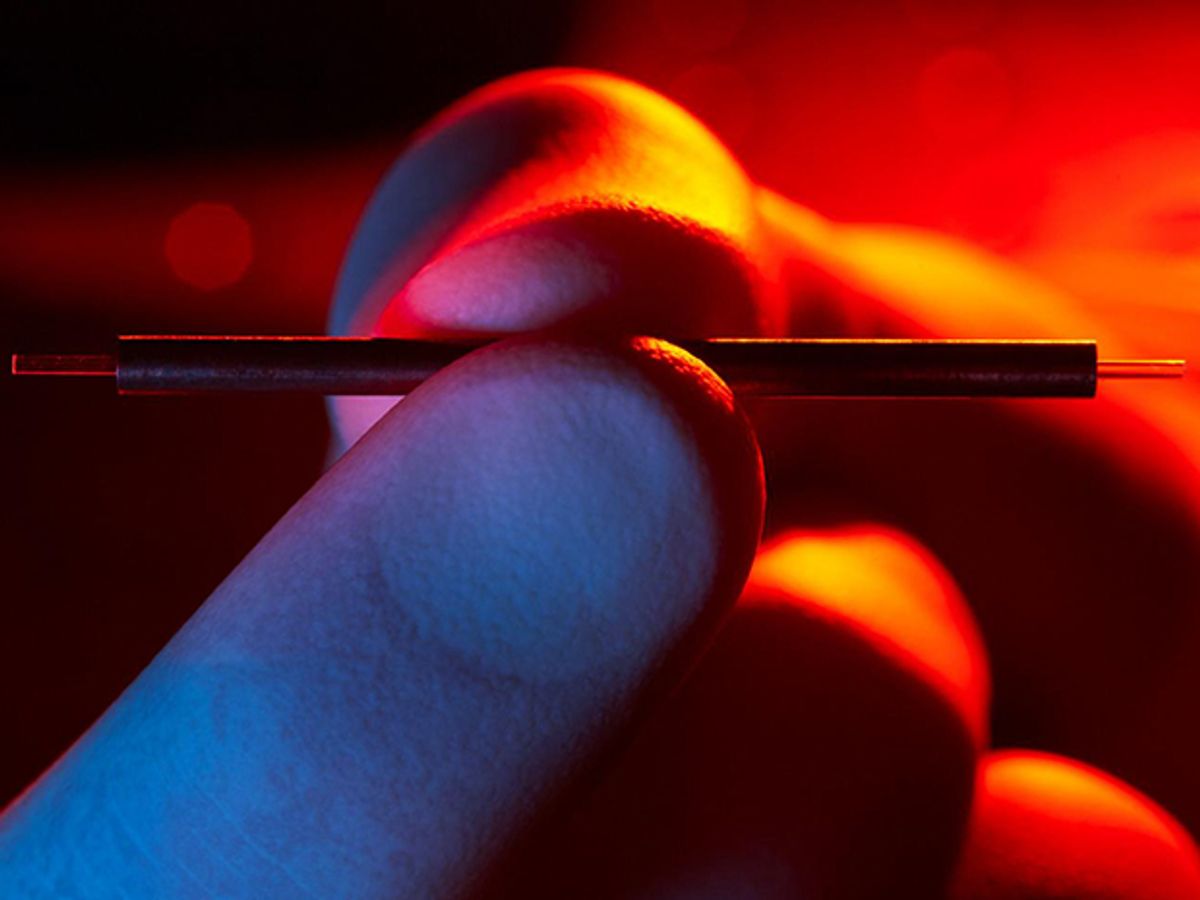An international research team has demonstrated a high-performance particle accelerator the size of a 1-millimeter mechanical pencil replacement lead.
Tens of thousands of particle accelerators around the world are used for more than physics research. They are also used to manufacture semiconductors, probe new materials, illuminate too-fast-to-follow chemical reactions, treat cancer, strengthen polymers, sterilize medical devices, and even to make diamonds green and pearls black.
A key accelerator parameter is the acceleration gradient, the energy (measured in mega electron volts, MeV) gained per meter of travel. The amount of energy the accelerator can pump into a cluster of particles, electrons, for example, thus becomes a function of the device’s gradient and length. And cost, of course, increases with physical size of the accelerator.
Thus, conventional linear accelerators, with acceleration gradients around 30–50 MeV/m, can grow as big as the 3,073-meter-long Stanford Linear Accelerator in Menlo Park, Calif., housed in what may be the world’s longest building. These machines accelerate charged particles using either a pulse of radio frequency radiation or a wakefield (using high energy “bunches” of electrons to blast a tunnel through plasma; when the tunnel collapses back on itself, following particles accelerate by riding the charged wake of the collapsing front). RF accelerators can reach energies of a few tens of mega electron volts before the RF energy itself begins to destabilize the mechanism in what’s called plasma breakdown. In wakefield approaches, balancing the skittish plasma bubble requires terawatt or petawatt lasers, tricky micromachinging, and femtosecond laser timing.
In Nature Communications, researchers describe an alternative: a compact device that uses pulses of terahertz (THz) radiation. The research group includes scientists from the Massachusetts Institute of Technology (MIT), the University of Toronto, and the Deutsches Electronen Synchrotron (DESY, the German Electron Syncrotron), the Center for Free-Electron Laser Science (CFEL), the Max Planck Institute for Structure and Dynamics, and the University of Hamburg (all in Hamburg, Germany). It was led by Franz Kärtner, who is affiliated with MIT, CFEL, and DESY.
“Terahertz frequencies provide the best of both worlds,” the group writes. “On one hand, the wavelength is long enough that we can fabricate waveguides with conventional machining techniques, provide accurate timing, and accommodate a significant amount of charge per bunch [of electrons]… On the other hand, the frequency is high enough that the plasma breakdown threshold for surface electric fields increases….”
The terahertz approach also allows them to use readily available picoseconds lasers.
The accelerator itself is a quartz capillary about 1.5 centimeters long and 940 micrometers in diameter, sheathed in a copper jacket. The quartz walls are 270 μm thick, leaving a central vacuum 400 μm in diameter.
In operation, a 0.45 THz pulse is radially polarized bounced off a mirror to enter at one end (call it the right end) of quartz tube. As the pulse traveled down the tube, electrons are injected at 60 keV through a pinhole at the left end. When the terahertz pulse reflects off the left wall (around the injection pinhole) it catches the electrons, accelerating them back towards the right.
In the initial experiments, the electrons could ride the wave for just 3 mm before the wave started to spread out. That short ride, however, boosted their energy to 67 keV. A back of the envelope calculation translates this modest energy gain into an acceleration gradient over 2 MeV/m.
“This is not a particularly large acceleration, but the experiment demonstrates that the principle does work in practice,” explains co-author Arya Fallahi of CFEL. “The theory indicates that we should be able to achieve an accelerating gradient of up to one gigavolt per meter.”
Or, as the paper itself concludes, “This proof-of-principle terahertz linear accelerator demonstrates the potential for an all-optical acceleration scheme that can be readily integrated into small-scale laboratories providing users with electron beams that will enable new experiments in ultrafast electron diffraction and X-ray production.”
Douglas McCormick is a freelance science writer and recovering entrepreneur. He has been chief editor of Nature Biotechnology, Pharmaceutical Technology, and Biotechniques.



